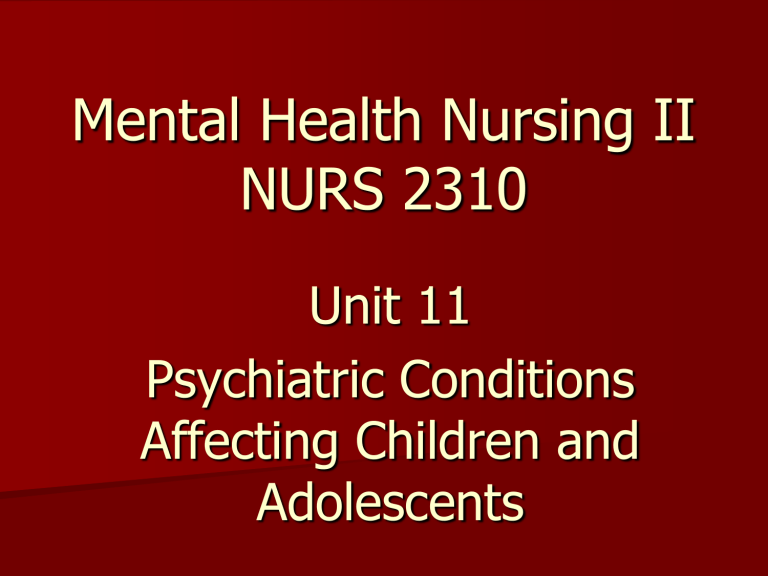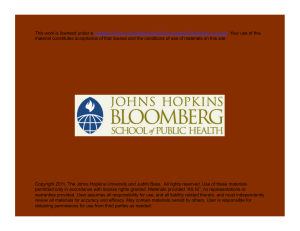Mental Health Nursing II NURS 2310 Unit 11 Psychiatric Conditions

Mental Health Nursing II
NURS 2310
Unit 11
Psychiatric Conditions
Affecting Children and
Adolescents
Objective 1
Identifying etiology and characteristics of specified childhood/adolescent psychiatric illnesses
Disorders Affecting Children/Adolescents
____________________________________
Intellectual Developmental Disorder
Autism Spectrum Disorder
Attention-Deficit/Hyperactivity Disorder
Oppositional Defiant Disorder
Conduct Disorder
Tourette’s Disorder
Separation Anxiety Disorder
Intellectual Developmental Disorder
Involves deficits in general intellectual functioning and adaptive functioning
–
–
General intellectual functioning = measured by an individual’s performance on IQ tests
Adaptive functioning = refers to the person’s ability to adapt to the requirements of daily living and the expectations of age and cultural group
IQ is 70 or below
Deficits/impairment in communication, selfcare, self-direction, leisure, and safety
Intellectual Developmental Disorder (cont’d)
Predisposing factors:
– Hereditary
Approximately 5% of cases
Down’s syndrome, Tay-Sachs disease
– Early alterations in embryonic development
Drug/alcohol toxicity
Maternal illnesses/infections
– Pregnancy and prenatal problems
Birth injuries
– General medical conditions acquired in infancy or early childhood
– Environmental influences and other mental disorders
Autism Spectrum Disorder
Characterized by a withdrawal into the self and into a fantasy world of one’s own creation
Development in social interaction and communication is markedly abnormal or impaired
Activities and interests are restricted; may be considered bizarre
Prevalence of approximately 1 in 150 children in the U.S.
Onset occurs before age 3
Attention-Deficit/Hyperactivity Disorder
(ADHD)
Persistent pattern of inattention and/or hyperactivity-impulsitivity that is more frequent and severe than is typically observed in individuals at same developmental level
Hyperactivity = excessive psychomotor activity that may be purposeful or aimless, accompanied by physical movements that are usually more rapid than normal
Impulsitivity = acting without reflection and without thought to the consequences
ADHD (cont’d)
Onset of disorder difficult to diagnose in children younger than age 4
ADHD often not recognized until child enters school
Five to nine times more common in boys than in girls
Believed to have strong genetic component
– Parent with ADHD may have child with ADHD
– Sibling string
Possible link to high serum lead levels
Oppositional Defiant Disorder (ODD)
Characterized by a pattern of negativistic, defiant, disobedient, and hostile behavior toward authority figures that occurs more frequently than is usually observed in individuals of same age/developmental level
Typically begins by age 8, and usually not later than early adolescence
May precede a conduct disorder
“Normal” oppositional phases occur in older infancy, toddlerhood, and adolescence
Conduct Disorder
Repetitive and persistent pattern of behavior in which basic rights of others or major age-appropriate societal norms or rules are violated
Physical aggression common
Childhood-onset = begins prior to age 10; more likely to have continued problems during adolescence, and antisocial as adult
Adolescent-onset = absence of any criteria characteristic of conduct disorder before age 10
Tourette’s Disorder
Presence of multiple motor tics along with one or more vocal tics
Tics may appear simultaneously or at different periods during the illness
Causes marked distress or interferes with various areas of functioning
Onset occurs before the age of 18
Characterized by periods of remission
Symptoms usually diminish during adolescence and adulthood
Separation Anxiety Disorder
Involves excessive anxiety concerning separation from the home or from those to whom the person is attached
Considered in excess of what would be expected for developmental level
Interferes with social, academic, and occupational levels of functioning
More common in girls than in boys
Etiological factors may include stressful life events and/or family influences
Objective 2
Examining medical treatments and nursing interventions for clients experiencing a childhood/adolescent psychiatric disorder
Behavior Therapy
– Classical conditioning, operant conditioning
– Useful for disruptive behavior disorders
Family Therapy
Family Education
– Behavior modification techniques
– Consistency
Group Therapy
– Opportunity to interact with peers
– Learning of appropriate social behaviors
Psychopharmacology
Objective 3
Exploring concerns associated with providing psychiatric care to children and adolescents
Medication issues
– Dosing problems
– Addiction
Legal issues
– Guardianship concerns
– Safety
Developmental issues
– Appropriateness of behaviors compared to norms of life stage
Parental/caregiver issues
– Manipulation of health care system
– Knowledge deficits
Objective 4
Applying the nursing process to the treatment of special populations
Assessment
Nursing Diagnosis
Planning
Implementation
Evaluation



